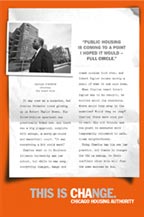May 2005
A Change for Plan

On May 27, a group of concerned citizens hijacked a million dollar Leo Burnett ad campaign designed for the Chicago Housing Authority, turning it into a scathing critique of Chicago’s public housing policy and privatization practices.
They created and changed out over a dozen large format bus shelter ads (5 in downtown Chicago in broad daylight!), put up thousands of ads on the trains, printed a newspaper of information and reproductions of the flipped ads, and created a mock Web site for the Chicago Housing Authority in the style of the official site.



See the old ads, download the new ads, and find out more about the campaign at ChicagoHousingAuthority.net:
“In late 2004, the Chicago Housing Authority (CHA) initiated a public relations campaign to put a new face on their Plan for Transformation, a plan that drastically reshapes the state of public housing in Chicago.
This PR campaign, authored by the advertising giant Leo Burnett, fused Chicago Housing Authority's acronym ‘CHA’ with the word ‘change’, resulting in a new brand identity: CHAnge. There are undoubtedly big changes happening with public housing in Chicago, including massive organizational restructuring within CHA and the tearing down of all high-rise public housing buildings.
Unfortunately, the priorities of CHA haven’t changed at all, and public housing residents are still at the bottom of the list. While the CHAnge campaign has attempted to put a ‘resident empowerment’ spin on the Plan for Transformation, in reality the majority of public housing residents have been adversely affected by the massive restructuring. If you are a single working mother displaced by a home demolition, waiting over 6 months for a voucher to relocate as your children are shifted from school to school, CHAnge feels a lot more like CHAos....
The Plan for Transformation is a $1.6 billion blueprint that includes the demolition of 14,000 public housing units and the displacement of over 20,000 people. Not unlike the ‘urban renewal’ master plans of previous decades, the Plan For Transformation has linked motives. It is pushing poor people out of the now-coveted inner city neighborhoods and increasing the exchange value of existing public land through privatization. Developers such as Dan McLean are making millions building on the land adjacent to former CHA high-rises and getting huge city tax credits to subsidize their development. In addition, the city is making money by selling or leasing former CHA public land to private developers. In this way, large amounts of our city’s housing budget are being transferred into private hands. CHA CEO Terry Peterson was personally implicated in this when he was caught giving CHA bids to contractors like the Habitat Group in exchange for political contributions.”

Memory Virus
“The latest Sober variant is one of a relatively new type of ‘propaganda spam,’ meant to spread political messages rather than sell a product or service. Circulation of the worm coincides with ceremonies marking the 60th anniversary of the end of World War II in Europe and examples of subject lines it sends include ‘Dresden 1945’ and ‘Du wirst zum Sklaven gemacht!!!’ (‘You are made slaves!!!’).
We are updating our spam filter.”
American Graffiti
In January 1991, George Lakoff published Metaphor and War: The Metaphor System Used to Justify War in the Gulf. He showed the discourse of war as ‘a panorama of metaphor,’ documenting, for instance, the state-as-person metaphor “engaging in social relations within a world community.” It’s health is economic health. It’s well-being is wealth. And its strength is military strength.
“War in this metaphor is a fight between two people, a form of hand-to-hand combat. Thus, the US sought to ‘push Iraq back out of Kuwait’ or ‘deal the enemy a heavy blow,’ or ‘deliver a knockout punch.’ A just war is thus a form of combat for the purpose of settling moral accounts....
The fairy tale has an asymmetry built into it. The hero is moral and courageous, while the villain is amoral and vicious. The hero is rational, but though the villain may be cunning and calculating, he cannot be reasoned with. Heroes thus cannot negotiate with villains; they must defeat them. The enemy-as-demon metaphor arises as a consequence of the fact that we understand what a just war is in terms of this fairy tale.
The most natural way to justify a war on moral grounds is to fit this fairy tale structure to a given situation. This is done by metaphorical definition, that is, by answering the questions: Who is the victim? Who is the villain? Who is the hero? What is the crime? What counts as victory? Each set of answers provides a different filled-out scenario.”
There is, of course, no room in these stories for the horror of war or the possibility of popular dissent.
In March 2003, on the eve of the second invasion, Lakoff published Metaphor and War, Again, charting again how the state-as-person continued to circulate. Added to this is the Rescue Scenario in which W. saves the Iraqi people and Saddam’s neighbors, whom he is “threatening.”
While Lakoff shows how metaphors help form conceptual frames that explain and justify military action, Yusuf Progler shows how these are rendered literal in blood and steel — inscribed onto the machinery itself.
From January 1999, Racist and degrading graffiti rooted in America's military culture:
During the last hours of ‘Operation Desert Fox,’ the murderous Anglo-American pre-Ramadan assault on the Muslim population of Iraq, the Associated Press broadcast a photograph of a US Navy missile ‘festooned with disparaging graffiti.’ Subsequent news reports mentioned one of the ‘several inscriptions’ scrawled on the missile: ‘Here’s a Ramadan present from Chad Rickenberg.’
Almost immediately, the offensive graffiti was strategically denounced by Pentagon officials as a ‘rare exception.’ In a statement released to the press, the Pentagon stressed that the graffiti ‘does not reflect American policy’ toward Muslims, adding that the US appreciates the ‘important contributions of Muslim-Americans to the US military.’ But despite the official denial, and though it received no further media attention, the incident is symptomatic of a long-standing legacy.
Aside from the reality that ‘American policy’ toward Muslims has included bombing and starving Iraq into oblivion, letting Bosnians be murdered and raped by Serbian fascists, supporting Israeli aggression in Palestine and Lebanon, destabilizing Iran, and attacking Somalia, Sudan, and Afghanistan, the graffiti incident is instructive in a number of ways. For one thing, it provides a rare glimpse into American military culture....
One need only look to earlier instances for verification. During ‘Desert Storm,’ the 1991 precursor to Desert Fox, reporters discovered the Anglo-American tradition of scribbling messages on bombs. Graffiti of that war ranged from adolescent silliness, such as ‘Hi Mom’ and ‘Say Cheese,’ to a range of witty puns like ‘Seasons Beatings,’ to virulently racist and sexist remarks like ‘Mrs. Saddam’s sex toy’ or ‘a suppository for Saddam.’ While British airmen are known to write messages like, ‘Dear Saddam, have a shitty day, love from the RAF,’ Americans tend to write more sexualized graffiti, with one reporter noting ‘the most identifiably American’ graffiti includes phrases like ‘bend over Saddam.’
Sometimes, US airmen write messages in their own blood. Since all of the weapons are blown to smithereens, and since the graffiti is in English, it seems obvious that the pearls of wrath and wisdom are intended for the artists themselves, almost like an inside joke, which is occasionally made public by news reports....
There’s no doubt that Chad Rickenberg, who painted a Ramadan greeting on a bomb destined to destroy Iraqis, had heard stories of similar acts committed by his predecessors in 1991, when another generation painted its degrading graffiti on bombs also destined to kill Iraqis. The oral tradition in the military passes on its rites of passage, which become badges of honor and belonging.
But such attitudes and practices toward Muslims did not emerge with the recent aggressions against Iraq and Iran. The first American military adventure against the Muslim world was initiated by then president Thomas Jefferson in the early 19th century. Those valiant exploits led to the formation of the American Navy and Marines, and the creation of a racist and phantasmagoric folklore about Muslim ‘barbarians’ and their ‘harems,’ the former to be killed and the latter to be raped. After a bit more practice on Indians and Africans, American soldiers massacred ‘Moro’ Muslims in the Philippines, America’s ‘Indian territory’ of the 1890s. Today, a century later, America’s Indian territory is Iraq. And the legacy marches on.
Indeed, this is made quite clear in this May 5, 2055 photo published on the Marine Corps own Web site. It is a photo of a U.S. tank in Iraq dubbed the ‘New Testament.’ Not only is it written across the barrel beneath the bowed head of the operator, it is highlighted in the caption:
“Haditha Dam, Al Anbar, Iraq - The ‘New Testament’ a tank with 4th Tank Co., 1st Tank battalion attached to 3/25 prepares to lead the way during a recent mission. Photo by: Cpl. Ken Melton.”
See also: Bombing Iraq, on the functions of Iraqi graffiti.
On the Importance of Protest Graphics
Compare and contrast:

This is a crowd.

This is a movement.
There’s just nothing like a bold design to let them know what you want and when you want it.
Today’s excercise brought to you courtesy of Lincoln Cushing.
Motion and Movement
In that last blog item I’d written a line disdaining “media that dazzles instead of informs.”
I’ve been thinking about the AIGA MOVE conference, a two day affair on motion graphics design. It was painfully hip — lots of twenty-something, white guys with bad 70’s hair talking about their animated films, music videos, and electric art happenings. The reigning criteria seemed “Funny, Weird, or Cool.” The most useful and informative session was the only one on narrative — an odd number for an event billing itself on “stories in motion.”
But I struck out the line. It read as if I was saying these are mutually exclusive, which, of course, they are not. For a designer, I tend to be awfully suspicious of style — particularly of work that privileges style over clarity. But one musn’t forget the heart in the struggle for hearts and minds.
Favianna reminds me so:
“As a political poster artist, it is important for me to remind myself of ways to develop art that speaks to a mass base of people, so that my the art becomes something functional and not something to be purchased and sold. My posters don’t belong in galleries, they belong in schools, in the streets. Art in this country is commodified and transformed into something for commercial consumption. Our role as artists is to use our art to transform and inform a radical consciousness and to move the people.”
Must See TV
After this weekend’s massacre in Uzbekistan, the government has sealed off the roads into Andijan.  Journalists were forcibly removed from the city and unable to return. Along with the news. The government is blocking Web sites and broadcasts into the country by foreign news channels including BBC World, CNN and Russian network NTV. The state run television has replaced domestic news broadcasts in the region with art movies, music clips, and nature photos.
Journalists were forcibly removed from the city and unable to return. Along with the news. The government is blocking Web sites and broadcasts into the country by foreign news channels including BBC World, CNN and Russian network NTV. The state run television has replaced domestic news broadcasts in the region with art movies, music clips, and nature photos.
It’s not the first time we’ve seen the arts used as a deliberate means of stifling political engagement.
It won’t be the last.
From the New York Times, May 15:
“Executives at National Public Radio are increasingly at odds with the Bush appointees who lead the Corporation for Public Broadcasting.
In one of several points of conflict in recent months, the chairman of the Corporation for Public Broadcasting, which allocates federal funds for public radio and television, is considering a plan to monitor Middle East coverage on NPR news programs for evidence of bias, a corporation spokesman said on Friday.
The corporation’s board has told its staff that it should consider redirecting money away from national newscasts and toward music programs produced by NPR stations.”
Dear Emigre
Here’s an old rant from the archives. The file was last modified on October 10, 1999. I was responding to the anguish and lamentations about the “state of design” in those magazine pages. It took a few issues, but they eventually did print an edited version of my letter.
I would phrase things differently today, but in any case here’s the original text:
“Dear Emigre:
Here’s an idea for all your ennui: PRO-BONO. Doesn’t anyone out there believe in anything besides a clever italic or an ironic stock photo? ‘The state of design’? There’s a big wide world out there, and contrary to what you may or may not have read, things ain’t looking very pretty, friends.
What’s so bad about capitalism is not that it produces bad design or co-opts your concept... but that there’s a real human cost. (A severe one.) An environmental one, too. (A massive one.) While you were working on that comp late that night how many acres of rainforest vanished? How many children went to sleep cold and hungry? Or went to sleep forever because their parents couldn’t afford medical care? How many millions spent another birthday in jail? Or were ‘disappeared’ by a governor they didn’t vote for? Or were murdered because they spoke a different language or didn’t wear the proper veil? Or were raped by their employer... at the factory that made that shirt you’re wearing? Yeah, so what are you going to do about it?
There’s a difference between an annual report for Lockheed and an annual report from an NGO like, say, Amnesty International. Does anyone know what ‘samizdat’ means anymore? You designers have the tools of the media right under your pudgy little fingertips! Give a stage to the disenfranchised! Broadcast the voices of the invisible! Pry open the sleepy eyes of the complacent! Jam the media! Organize your work place! Speak truth to power! Venture forth into your community... Just get off your ass! ‘Resistance’ indeed. What the hell are we in this for anyway? A couple of blue ribbons? A fast buck? The esteem of your peers? A new look or a clever punch-line?
What will be your legacy? If you’re not part of the solution, you’re part of the problem. Stop your whining and do something.
P.S. Thanks for the great magazine.”
v3
Finally managed to upgrade the design a little, lose the tables, and integrate my old home-brew blog software with MovableType. Please let me know if you notice anything out of whack. I’ll check the error logs later, too.
The resulting code is an ugly hybrid, but it works for now and all my old URL’s live on. It’ll facilitate other improvements soon. The RSS and home pages are now static, too, so that should speed things up a little.
I meant to have all this done by the first of May to mark the blog’s three year anniversary, but have been crazy busy. Whatever happened to my eight-hour day?
Texting for Change
Is it still news that grassroots protest movements are using electronic media to facillitate political change? Here are two stories from the same week.
Ecuadoreans rebelled by radio, e-mail and text, Reuters, April, 23, 2005:
“Fed up with politicians, Ecuadoreans turned to local radio, text messages and the Internet to whip up a street rebellion this week that helped push their president Lucio Gutierrez out of office.
Gutierrez, a former army officer elected in late 2002, was waiting in Quito’s Brazilian embassy residence on Saturday for safe conduct to asylum in Brazil, three days after intense protests played their part in forcing him from office.
Buoyant protesters, including businessmen, housewives and students, described the demonstrations as a popular rebellion that grew through word of mouth, cellular telephone text messages and broadcasts on La Luna, a local radio station.
Many said the week-long rallies were a spontaneous reaction to frustration with what they saw as the government’s abuse of power and disappointment with leaders of all political colours....
Quito protesters took their name — the Forajidos, or the outlaws in Spanish — from criticism Gutierrez fired at them when demonstrators rallied outside his family home.
 Car windshield stickers and T-shirts carrying the logo soon appeared on Quito’s streets.
Car windshield stickers and T-shirts carrying the logo soon appeared on Quito’s streets.
When momentum started to build last week, La Luna began broadcasts calling for peaceful pan-banging demonstrations, protests with balloons and even demonstrations by lobbing rolls of paper towels.
One distributed e-mail showed an animated image of pots banging on the screen.
La Luna, a small independent Quito FM radio station that has a history of questioning the government, was key in mobilizing the rallies.
‘People came here to denounce things. When it started to get big the politicians turned up, but the people just shouted at them to get out,’ Tobar said.
As protests grew the Gutierrez government blocked La Luna’s signal, Tobar said, a charge the former government dismissed. Demonstrators began sending text messages with details of rallies when La Luna went briefly off the air.
Outside the Brazilian embassy residence, protesters have rallied for three days to demand their new government stop Gutierrez leaving the country. Many want to see him jailed.
La Luna blasted this week from the radio of a car parked outside the residence, keeping protesters up to date on new developments.
Gutierrez, who was jailed before for leading a coup, came to office with the popular support of the poor and Indian groups after promising populist reforms. But many said they felt betrayed by his tough economic policies.
The former government blamed Radio La Luna for fomenting violent protests on the streets and threatened legal action. But the radio station insists on its independence though manager Tobar acknowledged its open opposition to Gutierrez.”
Note the emphasis on a strong brand here, too.
Chinese cellphones fuel protest, NY Times, April 24, 2005:
“The thousands of people who poured onto the streets of China this month for the anti-Japanese protests that shook Asia were bound by nationalist anger but also by a more mundane fact: they are China’s cellphone and computer generation.
For several weeks as the protests grew larger and more unruly, China banned almost all coverage in the state media. It hardly mattered. An underground conversation was raging via e-mail, text message and instant online messaging that inflamed public opinion and served as an organizing tool for protesters.
The underground noise grew so loud that last Friday the Chinese government moved to silence it by banning the use of text messages or e-mail to organize protests. It was part of a broader curb on the anti-Japanese movement but it also seemed the Communist Party had self-interest in mind....
‘Chain letter’ e-mail and text messages urged people to boycott Japanese products or sign online petitions opposing Japanese ascension to the United Nations Security Council. Information about protests, including marching routes, was posted online or forwarded by e-mail. Banned video footage of protest violence in Shanghai could be downloaded off the Internet.
‘Text messages, instant messaging and Internet bulletin boards have been the main channels for discussing this issue,’ said Fang Xingdong, chairman of blogchina.com, a Web site for China’s growing community of bloggers. ‘Ten years ago, this would have been unthinkable.’
In Shanghai, the local police even sent out a mass text message to cellphone users the day before that city’s raucous protest. ‘We ask people to express your patriotic passion through the right channel, following the laws and maintaining order,’ the message said. Some marchers saw the message as a signal to proceed, while others took it as a warning.
In early 2003, text messaging and the Internet played a major role in helping people pass reliable information - and also unfounded rumors - about the outbreak of SARS at a time when the government was covering up the disease.
In the anti-Japan protests, people have sent old-fashioned chain letters to friends via e-mail or text message. Typical is a 23-year-old professional in Shanghai who asked to be identified for this article by her English name, Violet. She uses an instant messaging service on her work computer to communicate with 50 people on her ‘contact list.’...
About 27 percent of China’s 1.3 billion people own a cellphone, a rate that is far higher in big cities, particularly among the young. Indeed, for upwardly mobile young urbanites, cellphones and the Internet are the primary means of communication.
‘If people can mobilize in cyberspace in such a short time on this subject," said Wenran Jiang, a scholar with a specialty in China-Japan relations, "what prevents them from being mobilized on another topic, any topic, in the near future?’”
The protests eventually wrung an apology from the Prime Minister of Japan.
Oddly, while the China story made the NY Times. The Ecuador story was hardly picked up at all — and has disappeared from the swissinfo site where I first caught it. Is independent radio in Latin America not as “sexy” as cellphones in China?
A Threat to Peace, Interactive
Click-and-drag, or click on a state or icon to zoom in. Click on the water, or use the right-click menu to zoom out.
Based on the poster produced by the NYC Independent Media Center.
Built using DIY Map, with a little help from google-latlong.


